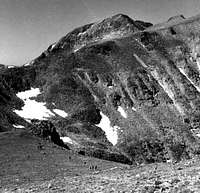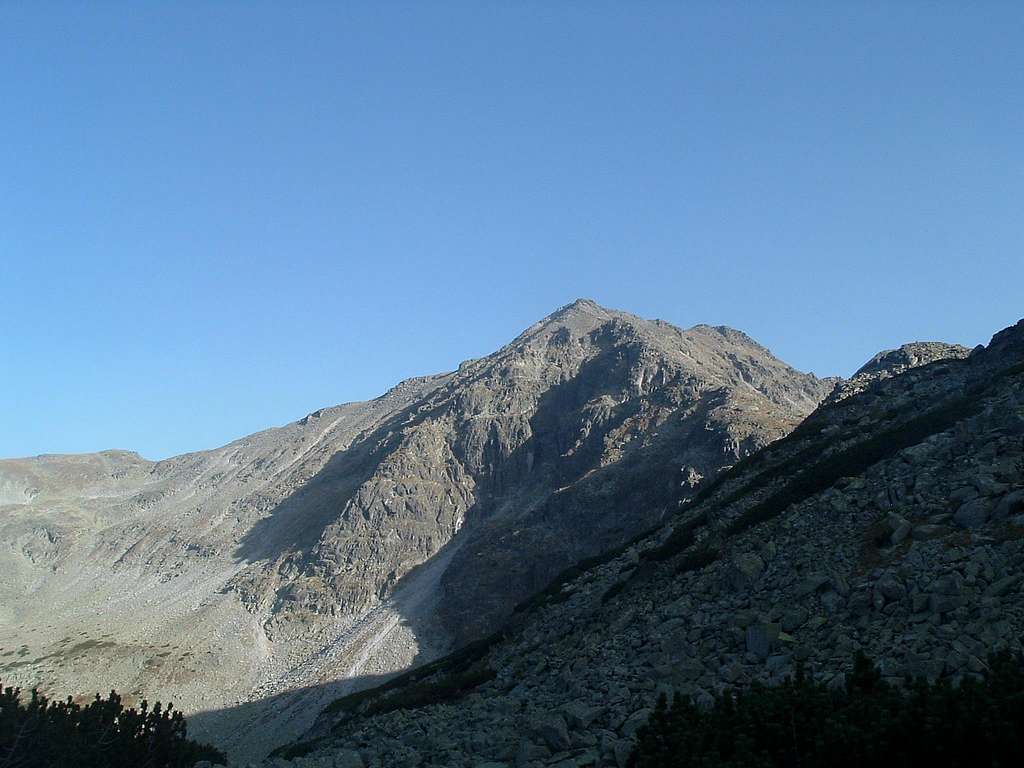|
|
Route |
|---|---|
|
|
42.11000°N / 23.35000°E |
|
|
Hiking, Scrambling |
|
|
Spring, Summer, Fall, Winter |
|
|
Most of a day |
|
|
Easy scramble (up to I UIAA); or hard scramble/easy climb (II-III UIAA) if following the ridge proper |
|
|
In memory...
The original author of this page, tjalfi, tragically died in the mountains in 2005. A short memorial note can be found on his user page. He remains the honorary author of this page.I adopted it in January 2008 and made some updates, leaving most of the original text and adding some more details and photos.
Overview
This route follows the ridge of Musala Cauldron. It offers an alternative, a bit more adventurous approach to Musala (2925 m), the highest peak of the Balkan Peninsula. Depending on your time and preferences you can choose from several ways of reaching and descending from the ridge.The peaks on the way are: Deno/Дeнo (2790 m), Ireček/Иpeчек (2852 m), Malka Musala/Maлкa Mусала (2902 m), Musala/Mусала (2925 m) and Aleko/Aлeко (2713 m). The trip can be shortened to Ireček, Malka Musala and Musala only.
The route is not marked and most of the way it is also untrodden, but the predominantly grassy terrain allows quite comfortable hiking with gorgeous views. For those who like scrambling, the most interesting part is the ridge from Ireček via Malka Musala to Musala. In most places, depending on your skills, you can either bypass the difficulties to make it an easy scramble - less than I UIAA or YDS class 3 (American), or try to follow the ridge proper wherever possible for some harder scrambling/easy rock climbing. You can even make it II-III UIAA (YDS class 4 to low 5). The scrambling bits are usually not sustained and are separated by easier sections.
If you don't follow the ridge proper all the time, this route is not very technically demanding, in spite of seeming as such at the first sight. Orientation is easy, as you follow the ridges most of the time.
For a more personal account of this route, see the trip report.
Approach
It is most convenient to approach from the north, from Borovec. Up to the Musala hut (Hiža Musala/Xижа Mусала) you can either go on foot along the path described in the normal Musala ascent route (by toc), or you can shortcut your way by taking the cable car from Borovec to Jastrebec and walking (30-45 min.) down the dirt road to the Musala hut.

Route description
At the Musala hut, follow the green-marked trail towards north-east which leads to a saddle, dividing the unimportant small peak of Groba (The Grave) from the last outpost of the Musala northern spur, Deno (2790m). Here abandon the marked trail and head out for the broad summit of Deno - an easy walk, combined with bumping over isolated boulders. When looking south from the top of Deno, the nearby Ireček (2852m) and Malka Musala (2902m) dominate the horizon. Walk down to a high meadowy col (2650-2700m) with a rock formation called Sfinksa (Sphinx).Deno can be skipped and the col with Sfinksa can be reached by an unmarked path directly from the Musala hut.




Hike on a long crest to the Ireček, which has several summits along its ridge. From Ireček onwards, get ready for a small deal of scrambling between Ireček and Malka Musala. Down to the col, bypass the rocks easily to your left or (more difficult) scramble down the crest of the ridge. Then scramble the easy rocks up to the summit of Malka Musala.
The ridge between Malka Musala and Musala is called Trionite (saw teeth). It is crumbled and is made up by a number of rock turrets.
Walk down to the west, parallelly to the ridge (on its left/south side), using a weak, obscure path. Or alternatively scramble the crest of the ridge, bypassing the hardest places where necessary (I-II UIAA). You will pass by a characteristic rock with a shape of a devil.
Here you have to join the path to bypass the high vertical rock barrier that drops down. Scramble easily several metres down a 'chimney' to reach the lowest point of the path. The 'chimney' used to be secured with a steel cable, which however got rusty and loose a long time ago - but this place is not very technically demanding anyway.
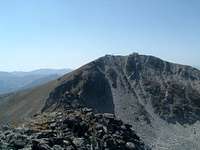
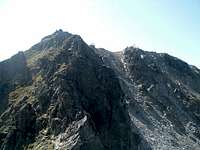

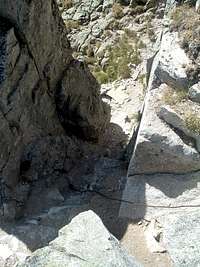

Then the path climbs up towards Musala, joining the ridge near its top. You can also return to the ridge much earlier for some more fun scrambling (up to II-III UIAA depending on the route that you choose). There is one more steel cable, also gone rusty and knackered. The final part of the ridge to the summit is easy.
The Musala main peak can be climbed in 5 hours from the Musala hut. You can descend to the Musala hut on the standard trail (about 1 hour) to the north-east.
You can also continue north along the ridge (some easy scrambling), via one more culmination, to the peak of Aleko (2713 m), follow a bit further north and walk down the steep grassy slopes to the Musala hut (1.15-1.30 h from Musala).
Another possibility is to go south via Bliznacite (The Twins) (2777 and 2779 m), Mariški vrh (2765 m) and Ovčarec (2768 m) to the col Džanka above the hut Grnčar (4-5 hours from the Musala peak). Together with the normal route from Musala hut, this route is a part of the Rila traverse.
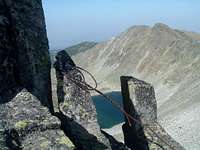
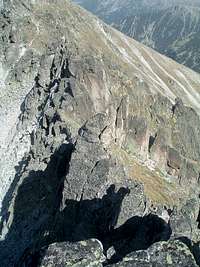
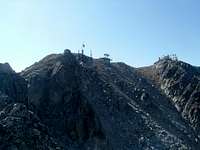
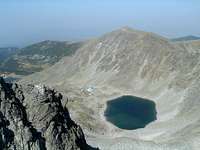
Essential gear & When to climb
Good hiking boots, standard hiking clothes and equipment, lots of water.The route can be hiked/climbed all year round, weather permitting. In winter conditions you'll need crampons, ice axe and full winter gear.
The peaks on the Musala ridge are connected by high cols, so you will not lose much elevation when making your way from one summit to the other, but the whole route is long and without a good path, so it can be exhausting for one, especially in a hot summer. There is no water on the ridge. Sometimes tea can be bought at Musala (but don't take it for granted). The scrambling sections do not require any special gear.
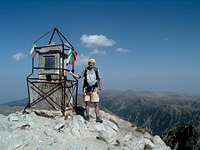
Names of the peaks
Musala means allegedly the Throne of Allah, or it might mean 'closer to God'. Names starting with Mus(s)- can be found elsewhere in the regions historically inhabited by the Turkic tribes (e.g. in Central Asia, or in the Caucasus).Malka Musala (Little Musala) used to be called Georgi Dimitrov after the famous Bulgarian Communist leader, but unlike Pik Lenina or Kommunizma, the summit did not retain its name after the collapse of Communism in Russia and Eastern Europe.
Ireček bears the name of a renowned Czech Balkanist, Mr Konstantin Ireček, who was also the minister of education in the first independent government of Bulgaria in the late XIX century.
Deno takes its name from the Bulgarian word den, meaning 'day'. In clear mornings the Sun casts purple alpenglow on it, marking the beginning of a new day.
Aleko has been named after Aleko Konstantinov, a XIX century writer, traveller and precursor of Bulgarian mountaineering.
Maps
Pилa, Kартография EOOД, 2006(Rila, Kartografija EOOD)
1:55000
Not very detailed but overall a good and reliable map, with names in both Cyrillic and Latin alphabet. It can be bought in many bookshops in Bulgarian cities and towns.



